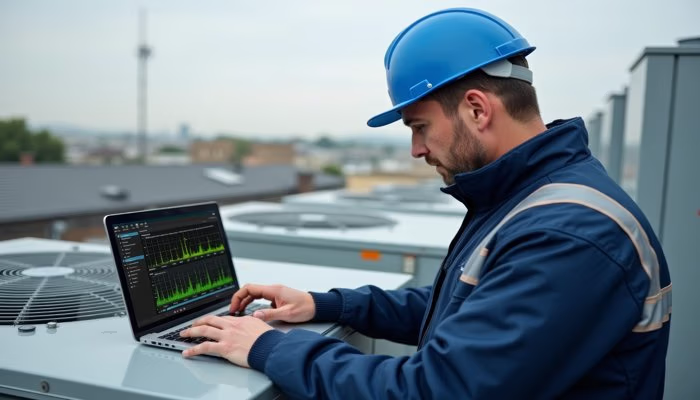Summary: Predictive Maintenance (PdM) involves maintenance based on equipment conditions, often leveraging techniques like analyzing vibration data, oil samples, and sensor readings. This proactive stance can diminish downtime and upkeep expenses while enhancing asset performance and availability. Lets see the basic info about Condition Monitoring vs Predictive Maintenance. Conversely, CBM monitors real-time equipment conditions to detect wear or fault indications. It involves machine surveillance coupled with data analysis from sources such as sensors and oil samples.
Predictive Maintenance
The concepts of maintenance and Condition-Based Maintenance (CBM) are both approaches to maintenance that focus on proactively addressing issues rather than waiting for equipment failures. By adopting these strategies, companies can enhance their maintenance processes, enhance asset performance, and lower maintenance expenses.
Understanding Predictive Maintenance
Maintenance is a method that utilizes data and analytics to forecast equipment breakdowns and determine the suitable timing for maintenance actions. Predictive Maintenance solutions can offer real-time insights by monitoring machinery health and performance using sensors. Identify anomalies that might indicate potential problems. This proactive approach empowers maintenance teams to tackle issues before they escalate, reducing downtime and cutting maintenance costs.
Advantages of Predictive Maintenance
The adoption of maintenance brings advantages to businesses. Initially, it facilitates a shift from reactive to maintenance, decreasing downtime and associated expenses. Additionally, Predictive Maintenance aids in optimizing resource allocation by ensuring that repairs are conducted when needed. This strategy minimizes unnecessary upkeep activities and prolongs the lifespan of equipment. Furthermore, Predictive Maintenance boosts reliability and asset performance by pinpointing problems. Overall, Predictive Maintenance enhances efficiency while reducing maintenance expenditures.
Implementation of Predictive Maintenance
To implement maintenance effectively, several steps must be followed. One of the steps involves setting goals and defining Key Performance Indicators (KPIs) that align with your business objectives. After that, choosing a maintenance solution tailored to your equipment and industry is essential. This selection process includes picking the sensors, algorithms, and software tools. The collection and analysis of sensor data play a role in monitoring equipment health and detecting any irregularities. Through the training of machine learning algorithms, patterns can be identified as failures. Valuable insights were provided. Lastly, integrating maintenance into your workflows ensures timely maintenance actions are taken when necessary, ultimately enhancing operational efficiency.
What keeps maintenance one step ahead?
Predictive solutions use real-time monitoring to prevent failures
Understanding Condition Monitoring
Condition Monitoring is a maintenance strategy involving equipment conditions to detect deviations or changes from operation parameters. It involves gathering data on equipment parameters such as vibration levels, temperature variations, pressure readings, and fluid analysis results. By keeping track of these parameters, condition monitoring solutions can pinpoint signs of deterioration, empowering maintenance teams to address any issues proactively.
Advantages of Condition Monitoring
Condition Monitoring offers several advantages for businesses. It facilitates fault detection and potential failure predictions, lowering the likelihood of breakdowns and reducing downtime risks. Maintenance teams can strategically plan their activities efficiently by assessing equipment conditions and reducing maintenance expenses. Monitoring the condition of equipment also plays a role in refining maintenance strategies by moving from reactive and routine maintenance towards Condition-Based Maintenance, where upkeep activities are carried out based on the actual state of the equipment.
How to Implement Condition Monitoring
To implement Condition Monitoring, it’s important to establish the parameters for monitoring and choose sensors for data collection. Defining thresholds and setting up alarms for each parameter helps detect anomalies and prompt maintenance actions. Collecting and analyzing monitoring data is crucial for spotting deviations and patterns. Utilizing Internet of Things (IoT) and Industry 4.0 technologies can boost the effectiveness of Condition Monitoring by facilitating real-time data transmission and remote monitoring. Integrating Condition Monitoring with maintenance strategies ensures that upkeep decisions align with the status of equipment conditions.
Condition Monitoring and Predictive Maintenance
While Condition Monitoring and Predictive Maintenance aim to prevent equipment failures and enhance maintenance efficiency, they diverge in their methodologies. Condition Monitoring involves observation of equipment conditions through data collection and analysis across parameters. It helps in recognizing deviations and patterns but does not provide predictions of failures. Conversely, Predictive Maintenance utilizes analytics and machine learning algorithms to forecast maintenance requirements based on historical data and real-time inputs. It delivers insights, along with recommendations, for upkeep tasks. Predictive Maintenance often involves using sensors, analytics software, and data analysis and machine learning expertise. When it comes to monitoring the equipment condition, you may need monitoring systems and skills to interpret the data effectively. It’s important to assess your organization’s capabilities to see if you have the resources or if you should consider investing in tools, software, or training.
Considering Equipment and Industry Factors
Consider the type of equipment you have and the industry you operate in. Some equipment, like rotating machinery or complex systems, could benefit more from maintenance due to their nature and intricate failure modes. Industries with safety standards and regulations may also see value in maintenance for compliance and risk mitigation. On the other hand, simpler equipment failure modes or industries with stringent maintenance requirements might find condition monitoring sufficient for decision-making support.
Setting Clear Objectives
Before rolling out maintenance initiatives, establish objectives and define Key Performance Indicators (KPIs) that align with your business objectives. Identify which specific equipment or processes will be included in maintenance efforts and outline expected outcomes such as reduced downtime or enhanced reliability.
Choosing the Right Predictive Maintenance Solution
Select a maintenance solution that fits well with your equipment and industry needs. Consider the types of sensors needed to gather data, the algorithms for analysis, and the software tools for visualization and decision-making support. Collaborate with trusted partners who can offer expertise and customized solutions tailored to your requirements.
Analyzing Sensor Data
Acquire sensor data from chosen equipment. Analyze it to detect patterns and irregularities. Ensure the data collection process is reliable with calibrated and maintained sensors. Utilize data visualization methods to extract insights and prioritize maintenance tasks based on risk levels.
Training Algorithms and Applying Machine Learning
Train machine learning algorithms using real-time data to create models continuously. Improve the algorithms as new data becomes available. Apply machine learning techniques like anomaly detection, pattern recognition and predictive analytics to improve prediction accuracy.
Incorporating Predictive Maintenance into Maintenance Processes
Merge maintenance with maintenance workflows and procedures. Ensure maintenance actions suggested by the maintenance system are effectively communicated to the maintenance team and integrated into the schedule. Monitor the efficacy of the maintenance program, refining it based on feedback and performance metrics.
Implementing Effective Practices for Condition Monitoring
Begin by outlining the parameters that require monitoring based on the equipment and potential failure modes. Choose sensors that accurately and reliably capture the necessary data. Consider factors like vibration, temperature, pressure, fluid analysis, and other relevant parameters depending on the equipment’s criticality and complexity.
Establishing Thresholds and Alerts
Define thresholds and alerts for each parameter to detect any anomalies. Specify ranges for each parameter and configure alerts to activate when values surpass or drop below the designated thresholds. These alerts will signal maintenance teams about issues enabling action.
Gathering and Analyzing Monitoring Data
Gather monitoring data from the equipment’s installed sensors. Ensure a continuous data collection process. Employ data analysis methods to pinpoint deviations, trends, and patterns indicative of equipment degradation or possible failures. Integrate data visualization tools to view the equipment’s status and monitor changes over time.
Utilizing IoT and Industry 4.0 Innovations
Harness the Internet of Things (IoT) and Industry 4.0 technologies to elevate condition monitoring capabilities. Use connectivity and data transmission for real-time monitoring and remote access to monitoring information. This enables alerts and analysis no matter where you are located. Look into utilizing cloud-based platforms and advanced analytics tools to maximise condition-monitoring data.
Incorporating Condition Monitoring into Maintenance Strategies
Merge Condition Monitoring with your maintenance strategies and workflows. Utilize the monitoring information to guide maintenance decisions and schedule maintenance tasks based on the state of the equipment. Implement approaches for condition-based maintenance where maintenance activities are carried out when the equipment state meets a threshold or trends suggest a breakdown.
FAQ | Condition Monitoring And Predictive Maintenance
Can Predictive Maintenance and Condition Monitoring be used together?
Yes, Predictive Maintenance and Condition Monitoring can be used together to create a comprehensive maintenance strategy. Condition Monitoring provides real-time data on equipment condition, which can be used as input for predictive maintenance algorithms. This integration allows for continuous monitoring and proactive prediction of potential failures.
Which approach is more suitable for complex systems with multiple failure modes?
Predictive Maintenance is often more suitable for complex systems with multiple failure modes. Its ability to analyze large amounts of data and identify patterns makes it effective in detecting and predicting complex failures. Condition Monitoring can still be valuable as a complementary approach for continuous monitoring and early anomaly detection.
Do both approaches require specialized sensors?
Both approaches may require specialized sensors depending on the equipment and parameters being monitored. Predictive Maintenance often relies on a variety of sensors to collect data on different aspects of equipment performance. Condition Monitoring may also require specific sensors to monitor parameters such as vibration, temperature, or fluid analysis.
How can I ensure the success of a Predictive Maintenance or Condition Monitoring program?
To ensure the success of a Predictive Maintenance or Condition Monitoring program, it is important to establish clear objectives, select the right solution for your needs, and integrate the approach with your maintenance workflows. Additionally, regularly monitor and evaluate the program’s performance, collect feedback from maintenance teams, and continuously refine and improve the program based on insights and lessons learned.
What maintenance strategies complement the condition monitoring strategy?
Condition monitoring is most effective when combined with other maintenance strategies to create a comprehensive approach. These include:
- Corrective Maintenance – Addressing failures when they occur.
- Preventive Maintenance – Scheduled inspections and servicing.
- Predictive Maintenance – Using data trends to anticipate failures.
- Reliability-Centered Maintenance (RCM) – Prioritizing critical assets based on risk.
Image: Adobe Stock – Copyright: © Nay – stock.adobe.com





